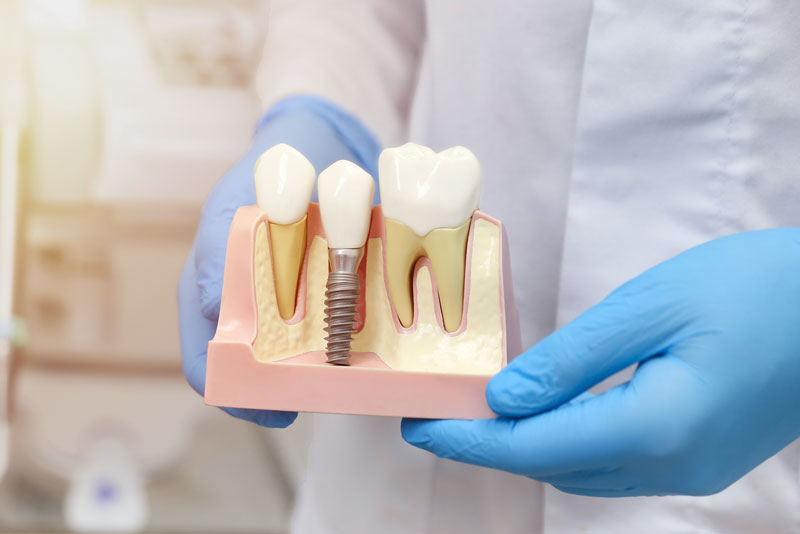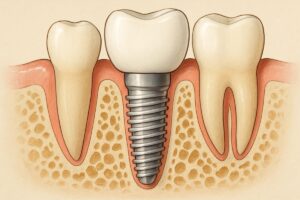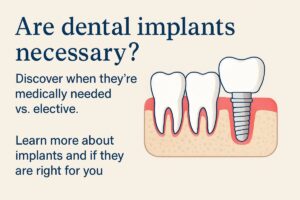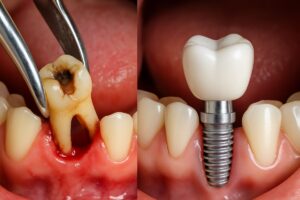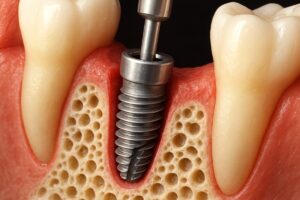If you’re asking “what is implant tooth in Austin, TX,” here’s a quick answer: an implant tooth is a titanium screw placed in the jaw that acts like a tooth root and holds a crown, bridge, or denture. This guide explains the steps, who needs one, and basic aftercare so you can decide your next move.
What is an implant tooth?
An implant tooth starts with a small titanium post surgically placed into the jawbone. After the bone heals around it, the post supports a crown, bridge, or full-arch prosthesis. The implant acts like a natural tooth root, giving strength and stability that dentures or bridges alone can’t match.
How implants differ from bridges and dentures: bridges rely on neighboring teeth for support, and dentures sit on the gums. Implants preserve bone, feel more like natural teeth, and usually last longer with proper care.
Step-by-step: How an implant tooth is placed
Consultation & 3D imaging
Expect a full exam and a CBCT 3D scan to map your jaw and nerves. The team will review your medical history, discuss goals, and create a digital treatment plan. This is where you’ll hear answers to “what is implant tooth in Austin, TX” specific to your anatomy and needs.
Surgery: placing the implant
Most implant placements use guided surgery based on your digital plan. You can get local anesthesia and sedation if needed. The surgeon places the titanium post into the bone, then closes the site or places a healing cap. The procedure usually takes under a few hours for a single implant.
Healing & osseointegration
Over several months the bone bonds to the implant — this is called osseointegration. Healing time varies but commonly takes 3–6 months. During this period you may have a temporary tooth or denture to keep comfort and appearance.
Final restoration
Once healed, your dentist takes digital impressions or photogrammetry to design the final crown, bridge, or full-arch prosthesis. Many practices use on-site labs and CAD/CAM milling to make custom restorations that fit precisely and look natural. The final prosthetic is attached and adjusted for bite and comfort.
Who needs an implant tooth and the benefits
People who commonly need an implant tooth include those with a missing tooth, a failing tooth that must be removed, or patients who want a stable option for loose dentures. Good candidates generally have reasonable overall health and enough bone volume.
- Benefits: improved chewing, clearer speech, natural appearance, and bone preservation.
- Alternatives if bone is low: bone grafting or advanced options like zygomatic or pterygoid implants for severe bone loss.
After getting an implant tooth in Austin, TX: recovery & care
Typical recovery after implant placement includes mild swelling and soreness for 2–4 days. Pain is manageable with over-the-counter or prescribed meds. Most people return to work within a few days, depending on the procedure and sedation used.
Daily care: brush gently around the implant, floss or use interdental brushes, and keep regular dental checkups. Avoid hard or sticky foods on a new implant until your provider clears you.
Watch for warning signs that need prompt attention: increasing swelling, persistent severe pain, fever, pus, or any feeling that the implant is loose. Contact your dental team right away if these occur.
Looking for implant tooth expertise near Austin, TX?
Union Dental Implant Center and Dr. Adam Carter oversee 3D planning, guided surgery, and in-house restorations for streamlined, precise implant care. Their team uses CBCT imaging, guided surgery software, and an on-site lab to design and place implants with careful planning and efficient timelines.
To schedule a consultation or learn more about “what is implant tooth in Austin, TX,” contact Union Dental Implant Center to set up an evaluation and 3D scan. They can review options, costs, and a personalized plan for your smile.

